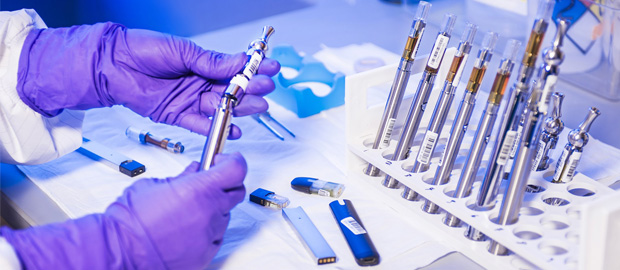What Healthcare Providers Need to Know about Vaping
Both the U.S Food & Drug Administration and the Centers for Disease Control are working determinedly to look into the disturbing occurrences of severe respiratory illness connected with the use of vaping products. Both organizations are diligently working with state and local health officials to investigate these incidents as fast as possible.
What Exactly is Vaping?
The use of e-cigarettes is often referred to as “vaping” because many users are certain e-cigarettes produce a vapor, which is then inhaled. In truth, however, e-cigarettes create an aerosol made up of minuscule particles, which is different from vapor.
Moreover, the e-liquid in most e-cigarettes includes nicotine, the equivalent addictive drug that is in everyday cigarettes, cigars and other such tobacco products.
However, nicotine levels are not the same in all types of e-cigarettes and, now and again, product labels don’t list the true nicotine content. In addition, some e-cigarette brands that assert that they are nicotine-free have been found to contain nicotine.
So, What is This “Vapor?”
Although the term “vapor” may sound risk-free, the aerosol that comes out of an e-cigarette is not water vapor and can be dangerous. As mentioned, the aerosol from an e-cigarette can contain nicotine and other substances that can trigger lung and heart disease and cancer.
What’s especially distressing is that e-cigarettes are threatening to addict a whole new generation to nicotine. E-cigarette use among young persons, many of whom were not smokers in the first place, has skyrocketed in recent years. In 2020, CDC and FDA data revealed that at least 3.6 million U.S. youth, including about 1 in 5 high school students and about 1 in 20 middle school students, had used e-cigarettes in the past 30 days.
Again, it’s essential to understand that there is plenty of evidence that nicotine impairs the brain development of teenagers and if used during pregnancy, it may also lead to premature births and low birthweight babies.
To make matters even worse, young persons who use e-cigarettes may be more likely to go on to use regular cigarettes. Moreover, many e-cigarettes are now available in kid-friendly flavors, such as mango and fruit, which make them even more attractive to youngsters.
What Can You Do as a Healthcare Provider?
Similar to tracking of tobacco use, tracking of e-cigarette or vaping product use is critical in identifying a patient’s health status.
- The Lung Association counsels that questions be added to a healthcare provider’s Electronic Health Records (EHR) to make certain that the use of e-cigarettes be included in a patient’s tracking so that the impacts on health can be monitored. Automated prompts and language which shows the words used by patients to imply vaping also should be added to EHRs.
- Additional questions need to be asked concerning e-cigarette usage when the patient is being checked by a healthcare professional. For example, have you ever used (and if so, do you now use every day, some days or not at all) electronic cigarettes? If a healthcare provider suspects e-cigarette, or vaping, product use related to lung injury, the CDC has recommendations for preliminary clinical assessment and follow-up, which contains the patient’s history, physical exam, lab testing, imaging and consultation with a specialist.
*Note: Doctors may also recognize e-cigarette products as vape-pens, JUULS, vapes, e-hookahs or e-vaporizers. Some look exactly like cigarettes, while others look like thumb drives, pens or small pipes.
As this research goes forward, the CDC urges healthcare providers to report potential instances of lung injury connected with e-cigarette use or vaping to their local or state health departments for further investigation.
- If e-cigarette or vaping product use is suspected as a possible cause for a patient’s lung injury, a detailed history of the substance used, the sources and the devices used need to be acquired. This is outlined in the CDC’s Health Alert Network update.
- If the lung biopsy or autopsy is completed on a patient assumed to have a lung injury associated with e-cigarette or vaping product use, consider submission of fixed lung biopsy tissues or autopsy tissues to the CDC for assessment. Testing can consist of assessments for lipids or formalin-fixed (wet-lung) tissues that have not experienced normal processing.
- Guidance is available for typical specimen collection and storage for healthcare providers and public health laboratory employees involved where patients meet, or are highly suspected of meeting, the case definition for lung injury related to e-cigarette or vaping. For information on the submission of non-tissue samples, go to NCEHSampleLogistics@CDC.gov.
The Epidemic Among Youth
- Ask about e-cigarettes and vaping – including devices such as JUUL when examining patients for tobacco product use.
- Instruct patients about the dangers of tobacco product use, including e-cigarettes for young persons, and advise youth and young adults to quit.
- Learn about the various shapes and types of e-cigarettes and the hazards of e-cigarette use for young persons at CDC.gov/e-cigarettes.
The Lung Association keeps a substantial collection of information on e-cigarettes and lung health. Healthcare providers can share this information with patients who use e-cigarettes, parents and teens and anyone else to help educate them about the potential hazards of e-cigarette use. The Lung Association’s Lung HelpLine is also a huge resource for both youth and adults looking to quit. The HelpLine is free and available in over 250 languages by calling 1-800-LUNGUSA. To learn more, visit https://lung.org/ffs.
At Medwave, we love publishing content (such as the aforementioned information) for the benefit of medical providers and our partners. We offer cost-effective medical billing and credentialing services, second to none.
